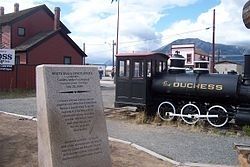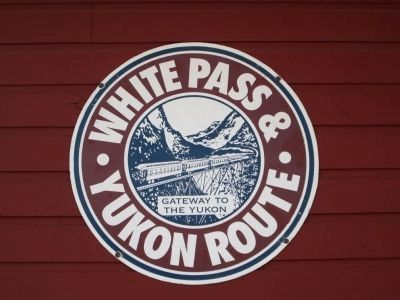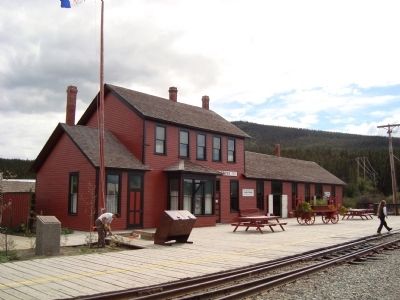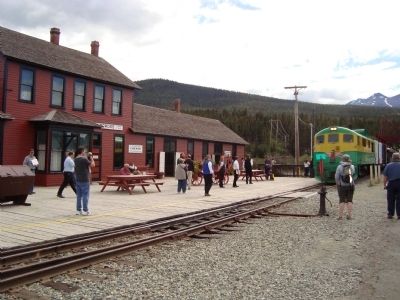White Pass & Yukon Route
Golden Spike Centennial
One hundred years later – on July 29, 2000 a new ceremonial spike was driven to honor the courage and dedication that built the first northern railway and to pledge a commitment to a second century of service.
Erected 2000 by Carcross, Yukon Territory, July 29.
Topics. This historical marker is listed in these topic lists: Railroads & Streetcars • Waterways & Vessels. A significant historical date for this entry is July 29, 1900.
Location. 60° 9.913′ N, 134° 42.208′ W. Marker is in Carcross, Yukon. Marker is on Tagish Avenue. This marker is in a park near the WP&YR Depot. Touch for map. Marker is in this post office area: Carcross YT Y0B 1B0, Canada. Touch for directions.
Other nearby markers. At least 3 other markers are within walking distance of this marker. A different marker also named White Pass & Yukon Route (a few steps from this marker); James “Skookum” Jim Mason (about 120 meters away, measured in a direct line); Carcross during World War II (about 180 meters away).
Regarding White Pass & Yukon Route.
J.H. Brownlee surveyed the town site in 1899 for the White Pass & Yukon Route (WP&YR)... The town was established by WP&YR to maintain the rail line and connect freight and passengers to Atlin and points around the lake via the sternwheelers.
--Taken from Carcross Historic Buildings Walking Tour.
Also see . . .
1. Carcross, Yukon Territory - Wikipedia. (Submitted on November 10, 2011, by Barry Swackhamer of Brentwood, California.)
2. White Pass & Yukon Route – Wikipedia Entry. “The line was born of the Klondike Gold Rush of 1897. The most popular route taken by prospectors to the gold fields in Dawson City was a treacherous route from the port in Skagway or Dyea, Alaska, across the mountains to the Canadian border at the summit of the Chilkoot Pass or the White Pass. There, the prospectors were not allowed across by Canadian authorities unless they had one ton of supplies. This usually required several trips across the passes. There was a need for better transportation than pack horses used over the White Pass or human portage over the Chilkoot Pass.” (Submitted on August 11, 2012.)
Credits. This page was last revised on June 16, 2016. It was originally submitted on November 10, 2011, by Barry Swackhamer of Brentwood, California. This page has been viewed 1,082 times since then and 15 times this year. Last updated on April 8, 2014, by Richard E. Miller of Oxon Hill, Maryland. Photos: 1, 2. submitted on November 10, 2011, by Barry Swackhamer of Brentwood, California. 3. submitted on July 16, 2015, by Rev. Ronald Irick of West Liberty, Ohio. 4, 5, 6. submitted on November 10, 2011, by Barry Swackhamer of Brentwood, California. • Bill Pfingsten was the editor who published this page.





